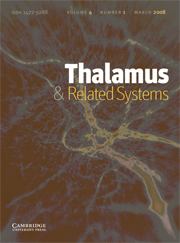Crossref Citations
This article has been cited by the following publications. This list is generated based on data provided by
Crossref.
Temel, Yasin
Visser-Vandewalle, Veerle
Aendekerk, Brenda
Rutten, Bart
Tan, Sonny
Scholtissen, Bart
Schmitz, Christoph
Blokland, Arjan
and
Steinbusch, Harry W.M.
2005.
Acute and separate modulation of motor and cognitive performance in parkinsonian rats by bilateral stimulation of the subthalamic nucleus.
Experimental Neurology,
Vol. 193,
Issue. 1,
p.
43.
Temel, Yasin
Blokland, Arjan
Steinbusch, Harry W.M.
and
Visser-Vandewalle, Veerle
2005.
The functional role of the subthalamic nucleus in cognitive and limbic circuits.
Progress in Neurobiology,
Vol. 76,
Issue. 6,
p.
393.
Temel, Yasin
Blokland, Arjan
Ackermans, Linda
Boon, Peter
van Kranen-Mastenbroek, Vivianne H.J.M.
Beuls, E.A.M.
Spincemaille, Geert H.
and
Visser-Vandewalle, Veerle
2006.
Differential effects of subthalamic nucleus stimulation in advanced Parkinson disease on reaction time performance.
Experimental Brain Research,
Vol. 169,
Issue. 3,
p.
389.
Temel, Yasin
Kessels, Alfons
Tan, Sonny
Topdag, Alim
Boon, Peter
and
Visser-Vandewalle, Veerle
2006.
Behavioural changes after bilateral subthalamic stimulation in advanced Parkinson disease: A systematic review.
Parkinsonism & Related Disorders,
Vol. 12,
Issue. 5,
p.
265.
Tass, Peter A.
and
Hauptmann, Christian
2007.
Therapeutic modulation of synaptic connectivity with desynchronizing brain stimulation.
International Journal of Psychophysiology,
Vol. 64,
Issue. 1,
p.
53.
Hammond, Constance
Bergman, Hagai
and
Brown, Peter
2007.
Pathological synchronization in Parkinson's disease: networks, models and treatments.
Trends in Neurosciences,
Vol. 30,
Issue. 7,
p.
357.
Hauptmann, Christian
Popovych, Oleksandr
and
Tass, Peter A
2007.
Desynchronizing the abnormally synchronized neural activity in the subthalamic nucleus: a modeling study.
Expert Review of Medical Devices,
Vol. 4,
Issue. 5,
p.
633.
Hauptmann, Christian
and
Tass, Peter A.
2007.
Therapeutic rewiring by means of desynchronizing brain stimulation.
Biosystems,
Vol. 89,
Issue. 1-3,
p.
173.
Tass, Peter A.
Popovych, Oleksandr V.
and
Hauptmann, Christian
2009.
Encyclopedia of Complexity and Systems Science.
p.
626.
Perakis, Dimitrios A
Tagaris, George A
and
Nikita, Konstantina S
2009.
Theoretical approach to the basal ganglia thalamocortical network: oscillators and modulators.
BMC Neuroscience,
Vol. 10,
Issue. S1,
Latteri, Alberta
Arena, Paolo
and
Mazzone, Paolo
2011.
Characterizing Deep Brain Stimulation effects in computationally efficient neural network models.
Nonlinear Biomedical Physics,
Vol. 5,
Issue. 1,
Tass, Peter Alexander
and
Hauptmann, Christian
2014.
Encyclopedia of Computational Neuroscience.
p.
1.
Ratas, Irmantas
and
Pyragas, Kestutis
2014.
Controlling synchrony in oscillatory networks via an act-and-wait algorithm.
Physical Review E,
Vol. 90,
Issue. 3,
Blume, J.
Lange, M.
Rothenfusser, E.
Doenitz, C.
Bogdahn, U.
Brawanski, A.
and
Schlaier, J.
2017.
The impact of white matter lesions on the cognitive outcome of subthalamic nucleus deep brain stimulation in Parkinson’s disease.
Clinical Neurology and Neurosurgery,
Vol. 159,
Issue. ,
p.
87.
Tass, Peter A.
Hauptmann, Christian
and
Popovych, Oleksandr V.
2018.
Encyclopedia of Complexity and Systems Science.
p.
1.
Tass, Peter A.
Hauptmann, Christian
and
Popovych, Oleksandr V.
2020.
Synergetics.
p.
235.
Tass, Peter Alexander
and
Hauptmann, Christian
2022.
Encyclopedia of Computational Neuroscience.
p.
37.
Vega-Zelaya, Lorena
and
Pastor, Jesús
2023.
The Network Systems Underlying Emotions: The Rational Foundation of Deep Brain Stimulation Psychosurgery.
Brain Sciences,
Vol. 13,
Issue. 6,
p.
943.


